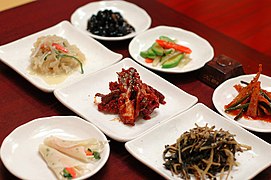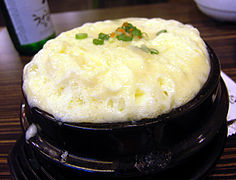Banchan: Difference between revisions
Italics |
Rescuing 1 sources and tagging 0 as dead. #IABot (v1.3) (Cyberpower678) |
||
| Line 132: | Line 132: | ||
===Bokkeum=== |
===Bokkeum=== |
||
[[Bokkeum]] (볶음) is a dish stir-fried with sauce. |
[[Bokkeum]] (볶음) is a dish stir-fried with sauce. |
||
*Kimchi bokkeum (김치볶음) - Stir-fried kimchi, often with pork<ref name="lk">{{cite web|url=http://www.lifeinkorea.com/food/Food.cfm?Subject=stirfry|title=Stir-fried dishes|publisher=Life in Korea|accessdate=2013-04-04}}</ref> (similar to ''jeyook bokkeum''). |
*Kimchi bokkeum (김치볶음) - Stir-fried kimchi, often with pork<ref name="lk">{{cite web|url=http://www.lifeinkorea.com/food/Food.cfm?Subject=stirfry |title=Stir-fried dishes |publisher=Life in Korea |accessdate=2013-04-04 |deadurl=yes |archiveurl=https://web.archive.org/web/20130309044824/http://www.lifeinkorea.com/Food/Food.cfm?Subject=stirfry |archivedate=2013-03-09 |df= }}</ref> (similar to ''jeyook bokkeum''). |
||
*Jeyook bokkeum (제육볶음) - Stir-fried pork with [[gochujang]] (chili pepper paste) sauce and onions.<ref>{{cite web|url=http://www.trifood.com/jaeyookbokum.asp|title=JAE-YOOK (KIM-CHI) BO-KUM|publisher=Trifood|accessdate=2013-04-04}}</ref> |
*Jeyook bokkeum (제육볶음) - Stir-fried pork with [[gochujang]] (chili pepper paste) sauce and onions.<ref>{{cite web|url=http://www.trifood.com/jaeyookbokum.asp|title=JAE-YOOK (KIM-CHI) BO-KUM|publisher=Trifood|accessdate=2013-04-04}}</ref> |
||
*[[Ojingeochae bokkeum]] (오징어채볶음) — Stir-fried [[dried shredded squid]] seasoned with a mixture of [[gochujang]] (chili pepper paste), garlic, and ''mullyeot'' (syrup-like condiment).<ref>{{cite web|url=http://www.doopedia.co.kr/doopedia/master/master.do?_method=view&MAS_IDX=101013000929031|script-title=ko:오징어채볶음|publisher=Doosan Encyclopedia|accessdate=2013-04-04|language=Korean}}</ref> |
*[[Ojingeochae bokkeum]] (오징어채볶음) — Stir-fried [[dried shredded squid]] seasoned with a mixture of [[gochujang]] (chili pepper paste), garlic, and ''mullyeot'' (syrup-like condiment).<ref>{{cite web|url=http://www.doopedia.co.kr/doopedia/master/master.do?_method=view&MAS_IDX=101013000929031|script-title=ko:오징어채볶음|publisher=Doosan Encyclopedia|accessdate=2013-04-04|language=Korean}}</ref> |
||
Revision as of 23:42, 7 May 2017
| Banchan | |
 | |
| Korean name | |
|---|---|
| Hangul | 반찬 |
| Hanja | 飯饌 |
| Revised Romanization | banchan |
| McCune–Reischauer | panch'an |
| IPA | [pan.tɕʰan] |
 |
| This article is part of a series on |
| Korean cuisine 한국 요리 조선 료리 |
|---|
Banchan (/ˈbɑːnˌtʃɑːn/,[1] from Korean: 반찬; 飯饌; banchan [pan.tɕʰan]) refers to small dishes of food served along with cooked rice in Korean cuisine. This word is used both in the singular and plural. The basic table setting for a meal called bansang (반상) usually consists of bap (밥, cooked rice), guk or tang (soup), gochujang or ganjang, jjigae, and kimchi. According to the number of banchan added, the table setting is called 3 cheop (삼첩), 5 cheop (오첩), 7 cheop (칠첩), 9 cheop (구첩), 12 cheop (십이첩) bansang, with the 12 cheop used in Korean royal cuisine.[2]
Banchan are set in the middle of the table to be shared. At the center of the table is the secondary main course, such as galbi or bulgogi, and a shared pot of jjigae. Bowls of cooked rice and guk (soup) are set individually. Banchan are served in small portions, meant to be finished at each meal and are replenished during the meal if not enough. Usually, the more formal the meals are, the more banchan there will be. Jeolla province is particularly famous for serving many different varieties of banchan in a single meal.[3]
History
Banchan is thought to be a result of Buddhist influence at around the mid-Three Kingdoms period and the subsequent proscription against eating meat by the monarchies of these kingdoms.[4] Thus, with the ban on meat-containing dishes, vegetable-based dishes rose in prominence and became the centrepoint of Korean cuisine;[4] court kitchens developed various methods for cooking, preparing and presenting these dishes, while less-affluent commoners produced smaller, simpler arrays of these vegetable-based dishes.[4]
Although the Mongol invasions of Korea ended the ban on meat-containing dishes, as well as meat offerings for rituals such as jesa, approximately six centuries of vegetable-based cuisine in the form of banchan had imprinted itself into Korean cuisine.[4]
Varieties
Kimchi

Kimchi is fermented vegetables, usually baechu (Napa cabbage), seasoned with chili peppers and salt. This is the essential banchan of a standard Korean meal. Some Koreans do not consider a meal complete without kimchi. Kimchi can be made with other vegetables as well, including scallions, gat (갓), and radish (무; mu).
| Name[5] | Korean name | Description |
|---|---|---|
| Nabak-kimchi | 나박김치 | Watery kimchi with less spicy baechu and mu |
| Dongchimi | 동치미 | Various vegetables in white brine. Nabak kimchi and dongchimi are referred to as mul kimchi (물김치), literally "water kimchi." |
| Geotjeori[6] | 겉절이 | Freshly made kimchi to be eaten crisp without fermenting. Usually made with baechu and lettuce. |
| Kkakdugi | 깍두기 | A kimchi made with cubed mu (white radish) |
| Oi sobagi | 오이 소박이 | Stuffed cucumbers kimchi, stuffed with chili, spring onions and buchu |
| Chonggak kimchi | 총각김치 | Whole mu with chili pepper seasoning. It is made with dallangmu, about the same size as sausages. |
| Yeolmu-kimchi | 열무김치 | Thin and small young summer radish kimchi, which can be prepared either with or without fermented jeotgal. |
| Pa kimchi | 파김치 | Hot and salty scallion kimchi, seasoned with lots of myeolchijeot, the Korean version of salted anchovies. |
| Gat kimchi | 갓김치 | Indian mustard leaf kimchi with a large amount of red pepper powder and the unique bitter taste and aroma. Strong myeolchijeot and glutinous rice paste are added to reduce the hot and bitter taste.[7] |
Namul

Namul (나물) refers to steamed, marinated, or stir-fried vegetables usually seasoned with sesame oil, salt, vinegar, minced garlic, chopped green onions, dried chili peppers, and soy sauce.
| Name[8][9] | Korean name | Description |
|---|---|---|
| Kongnamul | 콩나물 | Cold boiled bean sprouts with sesame oil. |
| Sigeumchi namul[10] | 시금치나물 | Lightly parboiled spinach dressed with sesame oil, garlic, and soy sauce. |
| Miyeok muchim[11] | 미역무침 | Miyeok (wakame, a seaweed) with sweet vinegar and salt. |
| Musaengchae/Muchae[12] | 무생채/무채 | Long julienned white radish in a sweet vinegar sauce, sometimes with ground dried chili peppers. |
| Gosari namul | 고사리나물 | Prepared fern shoots that have been stir-fried. |
| Chwinamul | 취나물 | Stir-fried and seasoned aster scaber. |
| Bireum namul[13] | 비름나물 | Parboiled and seasoned amaranthus. |
| Naengi namul[14] | 냉이나물 | Parboiled and seasoned shepherd's purse. |
| Dolnamul | 돌나물 | Raw Sedum with pepper sauce dressing. |
| Gogumasun namul[15] | 고구마순나물 | Boiled/seasoned sweet potato shoots. |
| Gaji namul | 가지나물 | Boiled eggplant. |
| Doraji namul | 도라지나물 | Boiled Chinese bellflower roots. |
Bokkeum
Bokkeum (볶음) is a dish stir-fried with sauce.
- Kimchi bokkeum (김치볶음) - Stir-fried kimchi, often with pork[16] (similar to jeyook bokkeum).
- Jeyook bokkeum (제육볶음) - Stir-fried pork with gochujang (chili pepper paste) sauce and onions.[17]
- Ojingeochae bokkeum (오징어채볶음) — Stir-fried dried shredded squid seasoned with a mixture of gochujang (chili pepper paste), garlic, and mullyeot (syrup-like condiment).[18]
- Nakji bokkeum (낙지볶음) - Stir-fried baby octopus in spicy gochujang sauce.[16]
- Buseot bokkeum (버섯볶음) - Stir-fried mushrooms such as pyogo, oyster mushrooms, pine mushrooms.[16]
Jorim
Jorim is a dish simmered in a seasoned broth.
- Dubu-jorim (두부조림) — Tofu simmered in diluted soy sauce, a little bit of sesame oil, minced garlic, and chopped green onion.[19]
- Jang-jorim (장조림) — Beef simmered in soy sauce, optionally with hard-boiled eggs or hard-boiled quail eggs.[20]
Jjim
Jjim is a steamed dish.
- Gyeran-jjim (계란찜) — Mixed and seasoned eggs steamed in a hot pot.[21]
- Saengseon jjim (생선찜)- Steamed fish.[22]
Jeon
Jeon denotes a variety of pan-fried, pancake-like dishes.[23] Buchimgae is a near synonym.
- Pajeon (파전) — Thin pancakes with scallions.[23]
- Kimchijeon (김치전) — Thin pancakes with old (ripe) Kimchi.[23]
- Gamjajeon (감자전) — Korean-style potato pancakes.[24]
- Saengseon-jeon (생선전) — Small portions of fish coated with eggs and pan-fried.[25]
- Donggeurang ttaeng (동그랑땡) — Patty made with tofu, meat and vegetables, coated with eggs and pan-fried.[26]
Others
- Danmuji (단무지) — A pickled radish marinated in a natural yellow dye made from gardenia fruit.
- Gyeran-mari (계란말이) — A rolled omelette, served in slices.
- Japchae (잡채) — A stand-alone dish in its own right, japchae can also be eaten as banchan. Japchae is glass noodles accompanied with a variety of vegetables and beef in a slightly-sweet garlic sauce.
- Korean-style potato salad (감자 샐러드) with apples and carrots.
Gallery
-
Various banchan served at a table
-
Table setting in Jeolla province with many banchan
-
Ojingeochae bokkeum (오징어채볶음)
-
Yeongeun jorim (연근조림)
-
Gyeran jjim (계란찜) in a hot pot
-
Samsaek jeon (삼색전), any three different colored jeon are referred to as such.
See also
References
- ^ Bhandari, Aparita (22 March 2017). "Learning how to eat banchan". Toronto Star. Retrieved 15 April 2017.
- ^ Template:Ko icon Making a bansang from Doosan Encyclopedia
- ^ Template:Ko icon Hanjeongsik from Naver open dictionary, food columnist Lee JinRang (이진랑), 2005-07-17
- ^ a b c d "About Banchan". Hannaone.
- ^ "Types of Kimchi". Korea Tourism Organization. Retrieved 2013-04-04.
- ^ 겉절이 (in Korean). Doosan Encyclopedia. Retrieved 2013-04-04.
- ^ Types of kimchi from Kimchi Time
- ^ "Korean Food: Seasoned Vegetables". Life in Korea. Retrieved 2013-04-04.
- ^ "Herbivore's delight – Spring namul". Korea.net (Dél-Koreai hivatalos oldala). 2012-04-10. Retrieved 2013-04-04.
- ^ "Spinach Side Dish Sigeumchi Namul (시금치나물)". Maangcshi.com. Retrieved 2013-04-04.
- ^ Sook Choe Ji, Yukiko Moriyama (2003). Quick and Easy Korean Cooking for Everyone. Japan Publications Trading. p. 42. ISBN 9784889961249.
- ^ 무생채 (in Korean). Doosan Encyclopedia. Retrieved 2013-04-04.
- ^ 비름나물 고추장무침 (in Korean). Allrecipes.kr. Retrieved 2013-04-04.
- ^ "Naengi namul (shepherd's purse namul)". Sanchon. Retrieved 2013-04-04.
- ^ "Gogumasun namul". Trifood. Retrieved 2013-04-04.
- ^ a b c "Stir-fried dishes". Life in Korea. Archived from the original on 2013-03-09. Retrieved 2013-04-04.
{{cite web}}: Unknown parameter|deadurl=ignored (|url-status=suggested) (help) - ^ "JAE-YOOK (KIM-CHI) BO-KUM". Trifood. Retrieved 2013-04-04.
- ^ 오징어채볶음 (in Korean). Doosan Encyclopedia. Retrieved 2013-04-04.
- ^ "두부조림(dubu jorim / Braised Pan-Fried Tofu)" (in Korean). Doosan Encyclopedia. Retrieved 2013-04-04.
- ^ "JANG-JO-RIM". Trifood. Retrieved 2013-04-04.
- ^ 계란찜 (in Korean). Sports Khan. 2013-03-13. Retrieved 5 April 2013.
- ^ "Saengseon Jjim Braised Fish With Radish in Seasoned Soy Sauce". The Korea Times. 2010-01-07. Retrieved 2013-04-05.
- ^ a b c "A List of Korean Savory Pancakes". About.com. Retrieved 2013-04-05.
- ^ 감자전 (in Korean). Donga. Archived from the original on 2004-02-27. Retrieved 5 April 2013.
- ^ "Saengseon Jeon (Pan-Grilled Fish With Egg)". Korea Timea. 2009-12-10. Retrieved 2013-04-05.
- ^ 동그랑땡 (in Korean). Donga Woman. 2006. Retrieved 2013-04-05.







